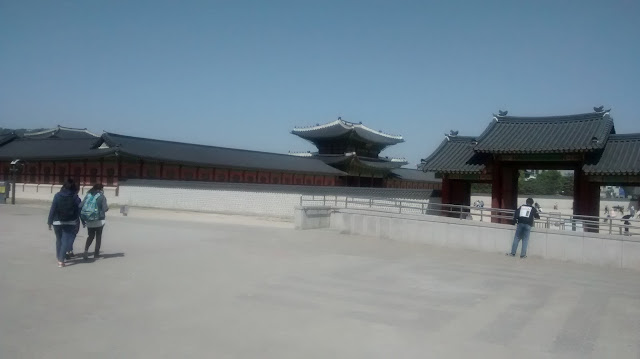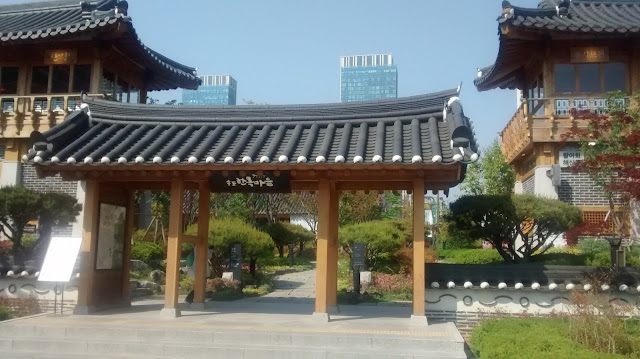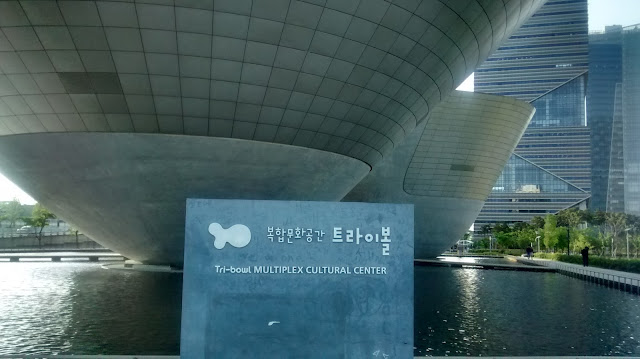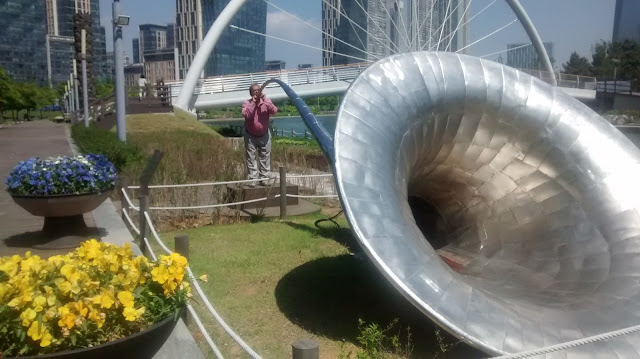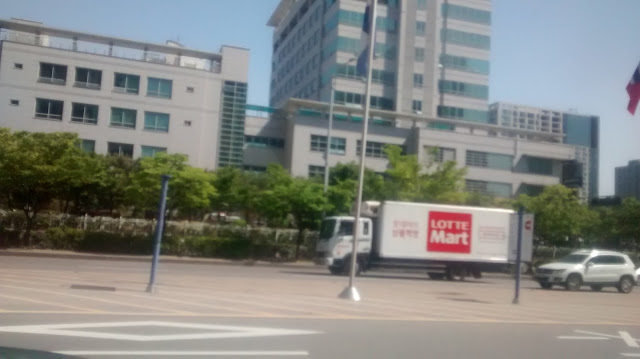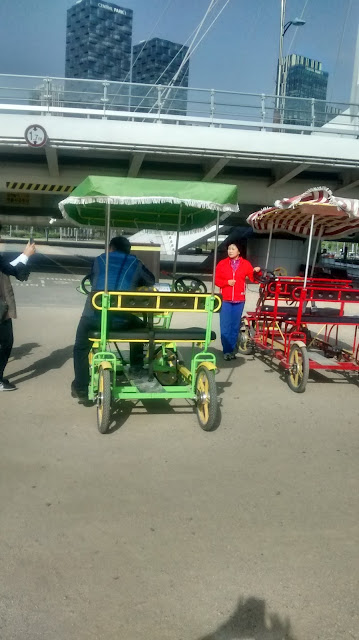Gyeong Bok Gung Palace, Seoul :
These were High School students who were allotted a project on
tourism as a part of social studies and for that they were providing us their services to the tourists as a guide. One of these helped us also.


-----------------------------------------------------------------------------
Few Important days in south Korea:
Memorial Day is an official remembrance day in the Republic
of Korea (South Korea) held on June 6 each year. It commemorates those who died
while in military service during wars or battles, primarily during the Korean
War.During the war, South Korea was supported by a UN force led by the USA,
while China and Soviet Union fought for North Korea
Memorial Day in South
Korea was first observed in 1956. It is traditionally marked with a solemn
remembrance ceremony that takes place at the National Cemetery in Seoul. At 10
a.m. on June 6, a siren rings throughout the country, announcing a moment of
silence for prayer, mourning and contemplation. The national flag is flown at
halt-mast during the day.
------------
------------
Independence Movement Day (삼일절)
March 1, is a national holiday in Korea. It’s the observance of March 1 Movement Day (삼일절), commemorating a day in which Koreans openly resisted the occupation by the Japanese and fought for their independence. It is also sometimes called the Samil Independence Movement.
On March 1, 1919, a series of demonstrations took place across Korea rallying for independence from Japanese occupation. Japan proclaimed its annexation of Korea in 1910, fully occupying the country, after having had a presence on the peninsula for years before that.
It began at 2 p.m. on March 1, 1919, with thirty-three nationalists who made up the core of the Samil Movement coming together at the Taehwagwan Restaurant in Seoul to read the Korean Declaration of Independence. The declaration had been drawn up by the historian Choe Nam-seon and the poet Manhae (also known as Han Yongun). At the same time, movement delegates read the independence proclamation at previous appointed locations throughout the country.....
----------
Seokga tansinil, 석가탄신일 — Buddha’s birthday, occurs on day 8 of month 4 on the lunar calendar. The Lotus Lantern Festival is held at this time in Korea. This holiday usually occurs in May on the Gregorian calendar.
-------
Jehunjul, 제헌절 — Constituation Day is July 17 and is a day to commemorate the constutition that was adopted July 17, 1948.
--------
Chuseok, 추석 — ..... It falls on the 15th day of the eighth lunar month, meaning that the date on our calendar changes every year, but it usually falls between mid-September and early October.
---------
Hangul Day, Oct. 9 — Celebrates the written language of Korea
------------
Public Holidays In South Korea – By Date
New Year’s Day (January 1st) Referred to as Solar New Years by most Korean citizens.
Lunar New Year (First Day of the First Month by the Lunar Calendar) One of the most celebrated holidays in Korea (and east Asia). Visiting family, worshipping ancestors, eating traditional Korean dishes and taking part in century old traditions all come to life during this color national holiday.
Korean Independence Day (March 1st) Koreans observe the anniversary of the March 1, 1919 Independence Movement against Japanese rule.
Arbor Day (April 5th) On this day, government officials, teachers, school children and thousands of Koreans throughout the country plant trees in accordance with the government’s reforestation program. Note: Not all Korean schools view Arbor Day as a true national holiday.
Children’s Day (May 5th)This is the day that Korean parents spoil their children with gifts, treats, games and trips to theme parks, zoo’s and other prominent area’s that are of interest to younger children.
Budhha’s Birthday (Eighth Day of the Fourth Month by the Lunar Calendar) Solemn rituals are held at Buddhist temples, and the day’s festivities are climaxed by a number of famous lantern parades across the country.
Memorial Day (June 6th) On this day the nation pays tribute to its war dead. Memorial services are held at the National Cemetery in Seoul.
Constitution Day (July 17th) This day commemorates the adoption of the Republic of Korea Constitution in 1948. Note: As of 2008 Constitution Day is no longer a Korean national holiday. Korea will continue to celebrate this day but government offices, schools and private businesses will remain open.
Liberation Day (August 15th) In 1945, Korea was liberated from Japan after 35 years of colonial rule. The day also marks the 1948 establishment of the government of the Republic of Korea.
Harvest Moon Festival – a.k.a Korean Thanks Giving (14th through the 16th of the Eighth Month of the Lunar Calendar) The most important national holiday of the year. During these 3 days Korean’s gather with family members to honor their deceased ancestors, clean off their ancestors tombs, give food and drink offerings, and pray.
National Foundation Day (October 3rd) This day marks the founding of Korea by Tan-gun (God-King) in 2333 B.C. Korean’s celebrate over 4000 years of history during this holiday.
Christmas Day (December 25th) Christians and other citizens celebrate this holy day as in the West.
South Korea :
South Korea is located in East Asia, on the southern half of the Korean Peninsula jutting out from the far east of the Asian land mass. The only country with a land border to South Korea is North Korea, lying to the north with 238 kilometres (148 mi) of border running along the Korean Demilitarized Zone. South Korea is mostly surrounded by water and has 2,413 kilometres (1,499 mi) of coast line along three seas. To the west is the Yellow Sea, to the south is the East China Sea, and to the east is Ulleung-do and Liancourt Rocks in the (East Sea). Geographically, South Korea's land mass is approximately 100,032 square kilometres (38,623 sq mi).[1] 290 square kilometres (110 sq mi) of South Korea are occupied by water. The approximate coordinates are 37° North, 127° 30 East.
South Korea :
South Korea is located in East Asia, on the southern half of the Korean Peninsula jutting out from the far east of the Asian land mass. The only country with a land border to South Korea is North Korea, lying to the north with 238 kilometres (148 mi) of border running along the Korean Demilitarized Zone. South Korea is mostly surrounded by water and has 2,413 kilometres (1,499 mi) of coast line along three seas. To the west is the Yellow Sea, to the south is the East China Sea, and to the east is Ulleung-do and Liancourt Rocks in the (East Sea). Geographically, South Korea's land mass is approximately 100,032 square kilometres (38,623 sq mi).[1] 290 square kilometres (110 sq mi) of South Korea are occupied by water. The approximate coordinates are 37° North, 127° 30 East.





